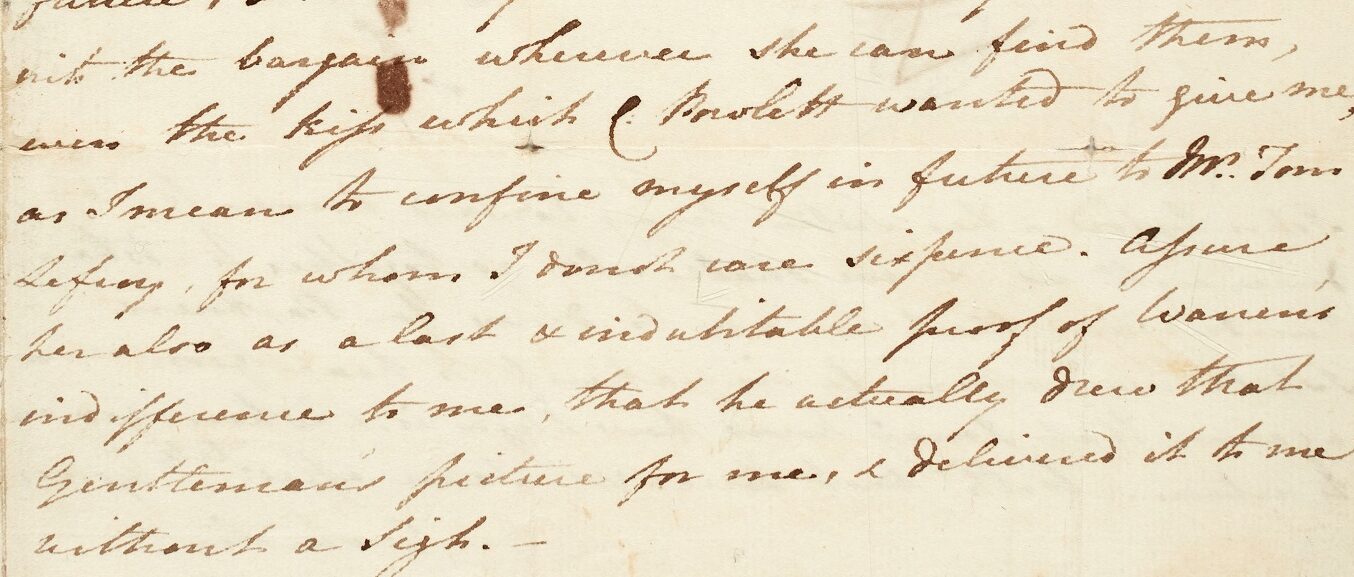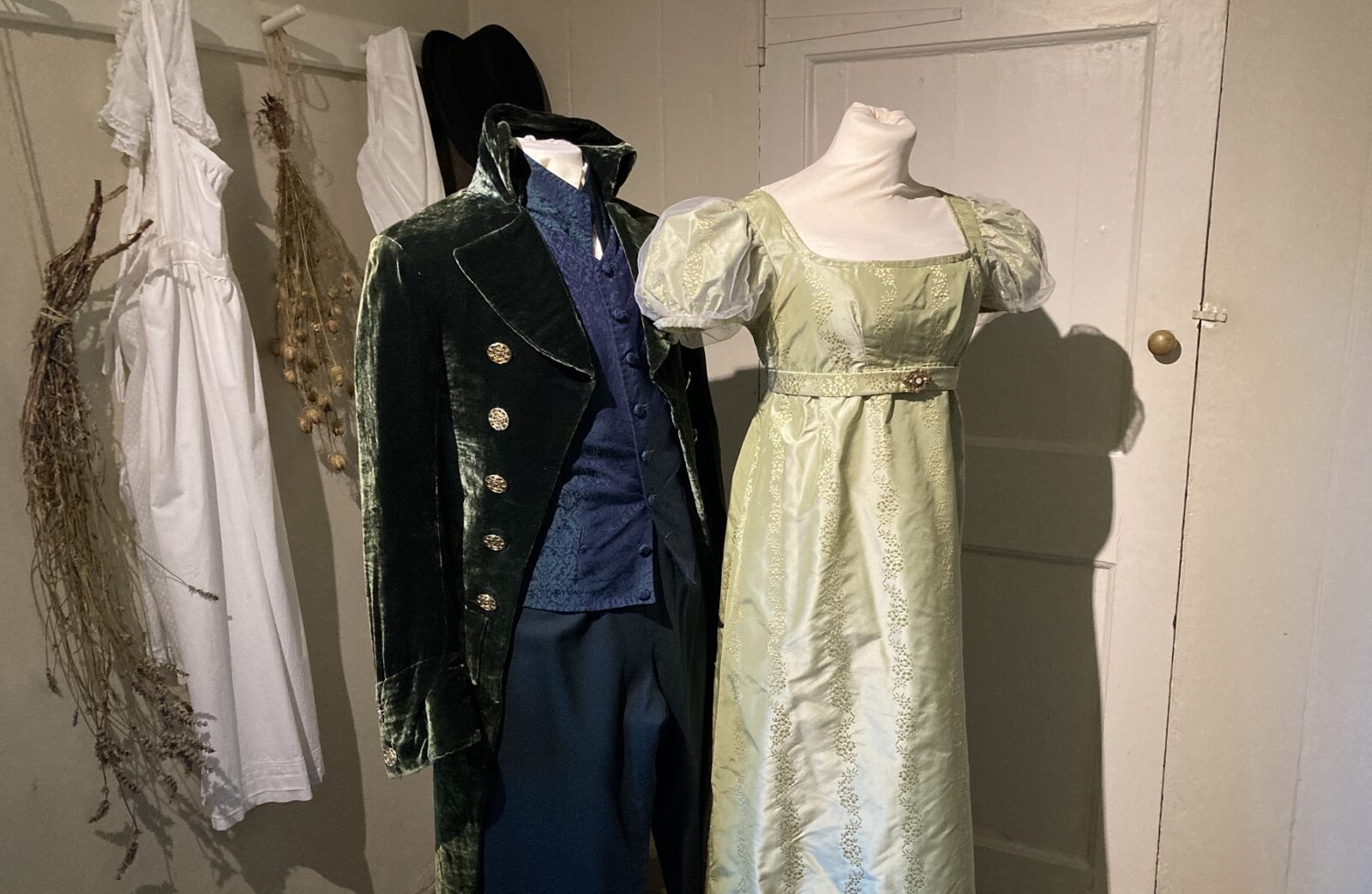Jane Austen in Love
An online version of our autumn/winter exhibition, exploring Jane's relationship with the dashing young Irishman Tom Lefroy. This exhibition brings together for the very first time Tom's portrait with Jane's letter in which she declares 'I am to flirt my last with Tom Lefroy'.‘Her sister and herself (Jane and Cassandra) are two of the prettiest girls in England…perfect beauties and of course gain hearts by dozens.’
Eliza de Feuillide to Philly Walter, August 1791
Jane Austen famously never married, but she did have admirers. The best known of these is Tom Lefroy, a clever young Irishman whom she met in December 1795. He had moved to London to study law and was spending the Christmas holidays with his uncle and aunt who lived in Ashe, near Steventon.
Jane had just turned 20 and was a bright, lively, pretty girl. Like her much-loved heroine Elizabeth Bennet, she enjoyed music and dancing, wit, laughter and lively conversation.
Although Tom only stayed in Hampshire for a few weeks, the pair met frequently at Christmas balls and parties. They danced, chatted and flirted, until Tom went back to London to resume his studies. Jane went back to work too – it was around then that she began writing First Impressions (later published as Pride and Prejudice).
It has been argued that Jane was in love with Tom, and that he left her heartbroken; however this seems unlikely. The tone of her letters to Cassandra is light and playful; she does not sound genuinely disappointed. But then we know that she was a realist. She might be romantic in her novels, arguing for mutual love in marriage, but she was also practical and knew how essential a sufficient income was to domestic happiness. Neither Tom nor Jane had the money to make a match possible.
We don’t even know if Jane wanted to marry, which would almost certainly have meant giving up any chance to be a writer. She certainly didn’t pursue marriage at all costs, as some of her female characters do. In 1802 she received an offer of marriage from the rich brother of a friend, that she accepted for one night and then declined. Her great love was her writing. Her books were her children – she famously referred to Pride and Prejudice as her ‘darling child’.
And what of Tom Lefroy? He returned to London and in 1796 became engaged to a Miss Mary Paul, the sister of a friend; they married two years later. He rose through the ranks to become Lord Chief Justice of Ireland. Years later, when asked about Jane Austen, he said that he had loved her, although he qualified this by saying it was ‘a boyish love’.
So where does that leave us? A pretty girl and her ‘Irish friend’. A young couple, ‘dancing and sitting down together’. Six novels, each full of men who flirt, dance, joke, behave well, behave badly… the men she knew in life surely went into this mix, and fed her imagination as she created Darcy, Knightley, Wentworth and the others… some of the most eligible gentlemen in the whole of literature.
~
Object 1: Letter from Jane Austen to Cassandra, 14-15 January 1796
Cassandra was away from home during Tom Lefroy’s stay in Hampshire, so Jane confided in her by letter. When they were apart the sisters wrote to each other constantly, however only two letters that mention Tom from this time survive.
This is the second of those letters – a new acquisition from the Blavatnik Honresfield Library that was saved for the nation in December 2021 and is now jointly owned by Jane Austen’s House and the Bodleian Library, Oxford.
This chatty letter was written over the course of two days preceding a ball, which Jane looks forward to with anticipation. She writes:
‘I look forward with great impatience to it, as I rather expect to receive an offer from my friend in the course of the evening. I shall refuse him, however, unless he promises to give away his white Coat.’
The ‘white Coat’ is a reference to Fielding’s Tom Jones, which Tom particularly admired. It was a racy novel for a couple to discuss on the dance floor, suggesting intimacy.
However if Jane expected the relationship to be taken further, she was disappointed. The next day she wrote:
‘At length the Day is come on which I am to flirt my last with Tom Lefroy, & when you receive this it will be over—My tears flow as I write, at the melancholy idea.’
Who knows if her tone here is mocking, melodramatic or truly heartbroken. The fact that she quickly moves on to other topics suggests that the fling with Tom was all a bit of fun; as Lydia Bennet would say, it was all a good joke.
~
Object 2: Portrait miniature of Tom Lefroy
This portrait of Tom Lefroy was painted in 1798, two years after he met Jane Austen. It was painted by George Engleheart, the great English miniaturist, and is signed with the artist’s distinctive cursive ‘E’. A second copy of the portrait is held by the Lefroy family.
In the portrait Tom is handsome, with light hair that was typical of the Lefroy family, deep blue eyes and a smile playing about his lips. He could easily be the hero of one of Jane’s novels and it has been suggested that he inspired her to create the character of Mr Darcy. It’s true they were both handsome, clever and well read, but there the similarities stop.
Darcy is a famously wealthy landowner; Tom had to work – he came from a large Irish family who depended upon him to make his fortune.
Darcy is notoriously proud: ‘above his company, and above being pleased’; Tom was a personable young man, perfectly comfortable in company. As Jane assured her sister:
‘he is a very gentlemanlike, good-looking, pleasant young man, I assure you.’
Jane Austen to Cassandra, Saturday 9-Sunday 10 January 1796
Private loan from Judy and Brian Harden
~
Object 3: Costumes from Becoming Jane (2007)
Here we reunite Jane and Tom, in clothing. These are the costumes worn by Anne Hathaway and James McAvoy in Becoming Jane, a film based on the 2003 book Becoming Jane Austen by Jon Hunter Spence.
The costumes were created by Irish designer Eimer Ní Mhaoldomhnaigh, drawing on fashions from the 1790s.
~
That’s it! You’ve reached the end of this virtual exhibition. Discover more online exhibitions and resources.




